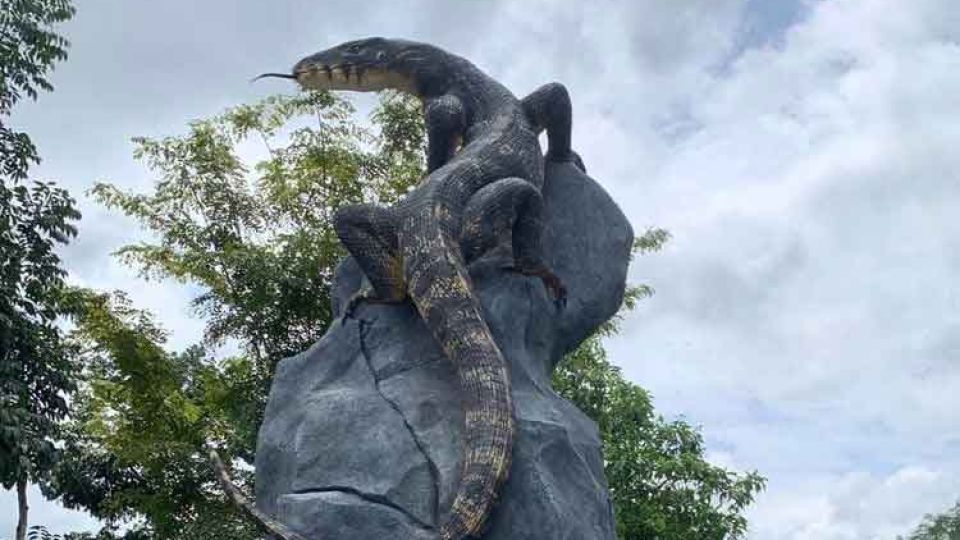April 28, 2025
JAKARTA – Amonitor lizard statue built by the Wonosobo administration in Central Java recently went viral for its striking realism and surprisingly low construction budget, sparking widespread online debate over other city monuments many netizens consider “ugly” and overpriced.
The 7-meter-tall monument depicts a large black monitor lizard with yellow spots, poised atop a large rock. Located in Krasak Village, Selomerto District, the statue has quickly become a popular photo spot for local residents since its completion last month.
The monument was created by local artist Rejo Arianto, a graduate of the Indonesian Institute of the Arts Surakarta, who is renowned for his public artwork throughout Wonosobo, including several showcased in local government buildings.
Rejo is primarily known for his paintings, and the lizard monument marks only the third sculpture he has ever created and the first to be commissioned by the government.
He made the monument in just 1.5 months with the help of members from the local youth organization Karang Taruna. The project was completed on a modest budget of Rp 50 million (US$3,100), funded through the corporate social responsibility (CSR) funds of Wonosobo-owned enterprises (BUMD).
Rejo explained that although the budget was tight, he managed to make it work because of his desire to contribute to his hometown.
“I didn’t create [the lizard monument] for profit. However, if it had been commissioned by another city, I would have needed a larger budget,” he said in a recent interview, as quoted by Kompas.
Rejo said the monitor lizard, locally known as menyawak, was chosen because it is a native species that is becoming increasingly rare in the region.
“Art is the expression of the soul. I hope this work serves as a reminder to protect our environment and encourages people to care more about this animal and its habitat,” Rejo said recently, as reported by Kompas.
Rejo’s lizard monument quickly went viral on social media, with many netizens praising his craftsmanship and saying the statue looks remarkably lifelike.
The monument’s surprisingly small budget also sparked widespread discussion online, with many netizens comparing it to statues in other cities—often deemed far less appealing despite being built with significantly larger budgets and sometimes funded by taxpayers.
Many have argued that Rejo’s artwork highlights the seemingly inflated budgets of various city monuments, raising suspicions that the surplus funds may have been misappropriated for personal gain.
One monument that has drawn significant criticism from netizens is the Irrawaddy dolphin statue in Samarinda, East Kalimantan, which was erected earlier this year by local authorities.
The Irawaddy dolphin is a critically endangered species of freshwater dolphin that lives in the Mahakam River in East Kalimantan. Its population has been steadily declining because of habitat destruction, overfishing and river pollution.
At 8 meters tall, the monument is made of steel covered in recycled plastic cables and cost the city Rp 1.1 billion to build. Designed in a contemporary, abstract style, it takes the form of a broken, looping ribbon, meant to symbolize the silhouette of a dolphin’s fin mid-leap.
However, many netizens have expressed skepticism, claiming they fail to see any resemblance to a dolphin. Some have humorously compared the statue to a broken rubber band, while others joked that it resembles a “dolphin from another dimension.”
Another monument that has attracted significant criticism from netizens is the elephant monument built by authorities in Gresik, East Java. Completed in 2020, the monument cost nearly Rp 1 billion, funded through the Corporate Social Responsibility (CSR) program of PT Petrokimia Gresik.
The design of the monument is abstract, with the elephant lacks eyes, ears and tusks. Officials stated that this abstraction was intentional, meant to comply with Islamic principles that discourage the creation of statues resembling living beings.
Officials emphasized that adhering to Islamic principles in the statue’s design was essential to honoring Gresik’s identity as a city with a deep Islamic heritage, often referred to as Kota Wali (City of the Saints) or Kota Santri (City of Islamic students).
However, netizens have humorously dubbed the statue a “premature elephant”, with some joking that the budget for its creation was “eaten by elephants.” (nal)


